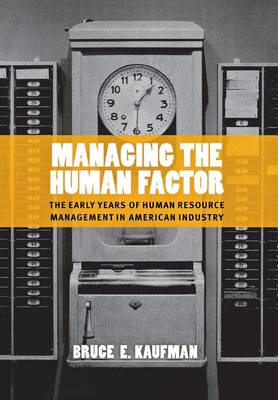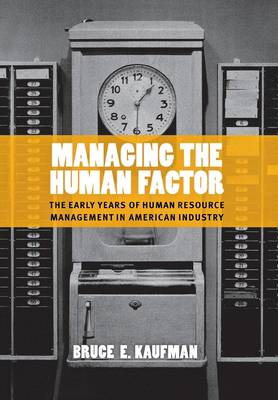
- Retrait gratuit dans votre magasin Club
- 7.000.000 titres dans notre catalogue
- Payer en toute sécurité
- Toujours un magasin près de chez vous
- Retrait gratuit dans votre magasin Club
- 7.000.0000 titres dans notre catalogue
- Payer en toute sécurité
- Toujours un magasin près de chez vous
Managing the Human Factor
The Early Years of Human Resource Management in American Industry
Bruce E KaufmanDescription
Human resource departments are key components in the people management system of nearly every medium-to-large organization in the industrial world. They provide a wide range of essential services relating to employees, including recruitment, compensation, benefits, training, and labor relations. A century ago, however, before the concept of human resource management had been invented, the supervision and care of employees at even the largest companies were conducted without written policies or formal planning, and often in harsh, arbitrary, and counterproductive ways.
How did companies such as United States Steel manage a workforce of 160,000 employees at dozens of plants without a specialized personnel or industrial relations department? What led some of these organizations to introduce human resources practices at the end of the nineteenth century? How were the earliest personnel departments structured and what were their responsibilities? And how did the theory and implementation of human resources management evolve, both within industry and as an academic field of research and teaching?
In Managing the Human Factor, Bruce E. Kaufman chronicles the origins and early development of human resource management (HRM) in the United States from the 1870s, when the Labor Problem emerged as the nation's primary domestic policy concern, to 1933 and the start of the New Deal. Through new archival research, an extensive review and synthesis of the historical and contemporary literatures, and case studies illustrating best (and worst) practices during this period, Kaufman identifies the fourteen ideas, events, and movements that led to the creation of specialized HRM departments in the late 1910s, as well as their further growth and development into strategic business units in the welfare capitalism period of the 1920s.
The research presented in this book not only uncovers many new aspects of the early development of personnel and industrial relations but also challenges central parts of the contemporary interpretation of the concept and evolution of HRM. Rich with insights on both the present and past of human resource management, Managing the Human Factor will be widely regarded as the definitive account of the early history of employee management in American companies and a must-read for all those interested in the indispensable function of managing people in organizations.
Spécifications
Parties prenantes
- Auteur(s) :
- Editeur:
Contenu
- Nombre de pages :
- 392
- Langue:
- Anglais
Caractéristiques
- EAN:
- 9780801442278
- Date de parution :
- 15-08-08
- Format:
- Livre relié
- Format numérique:
- Genaaid
- Dimensions :
- 155 mm x 234 mm
- Poids :
- 680 g

Les avis
Nous publions uniquement les avis qui respectent les conditions requises. Consultez nos conditions pour les avis.






